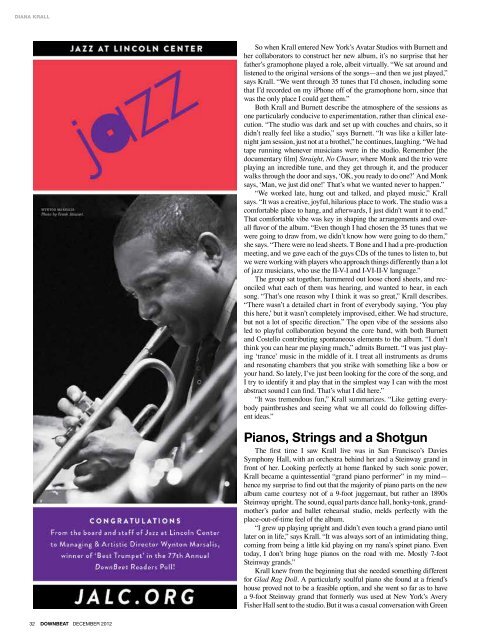Ron Carter Esperanza Spalding - Downbeat
Ron Carter Esperanza Spalding - Downbeat
Ron Carter Esperanza Spalding - Downbeat
Create successful ePaper yourself
Turn your PDF publications into a flip-book with our unique Google optimized e-Paper software.
DIANA KRALL<br />
So when Krall entered New York’s Avatar Studios with Burnett and<br />
her collaborators to construct her new album, it’s no surprise that her<br />
father’s gramophone played a role, albeit virtually. “We sat around and<br />
listened to the original versions of the songs—and then we just played,”<br />
says Krall. “We went through 35 tunes that I’d chosen, including some<br />
that I’d recorded on my iPhone off of the gramophone horn, since that<br />
was the only place I could get them.”<br />
Both Krall and Burnett describe the atmosphere of the sessions as<br />
one particularly conducive to experimentation, rather than clinical execution.<br />
“The studio was dark and set up with couches and chairs, so it<br />
didn’t really feel like a studio,” says Burnett. “It was like a killer latenight<br />
jam session, just not at a brothel,” he continues, laughing. “We had<br />
tape running whenever musicians were in the studio. Remember [the<br />
documentary film] Straight, No Chaser, where Monk and the trio were<br />
playing an incredible tune, and they get through it, and the producer<br />
walks through the door and says, ‘OK, you ready to do one?’ And Monk<br />
says, ‘Man, we just did one!’ That’s what we wanted never to happen.”<br />
“We worked late, hung out and talked, and played music,” Krall<br />
says. “It was a creative, joyful, hilarious place to work. The studio was a<br />
comfortable place to hang, and afterwards, I just didn’t want it to end.”<br />
That comfortable vibe was key in shaping the arrangements and overall<br />
flavor of the album. “Even though I had chosen the 35 tunes that we<br />
were going to draw from, we didn’t know how were going to do them,”<br />
she says. “There were no lead sheets. T Bone and I had a pre-production<br />
meeting, and we gave each of the guys CDs of the tunes to listen to, but<br />
we were working with players who approach things differently than a lot<br />
of jazz musicians, who use the II-V-I and I-VI-II-V language.”<br />
The group sat together, hammered out loose chord sheets, and reconciled<br />
what each of them was hearing, and wanted to hear, in each<br />
song. “That’s one reason why I think it was so great,” Krall describes.<br />
“There wasn’t a detailed chart in front of everybody saying, ‘You play<br />
this here,’ but it wasn’t completely improvised, either. We had structure,<br />
but not a lot of specific direction.” The open vibe of the sessions also<br />
led to playful collaboration beyond the core band, with both Burnett<br />
and Costello contributing spontaneous elements to the album. “I don’t<br />
think you can hear me playing much,” admits Burnett. “I was just playing<br />
‘trance’ music in the middle of it. I treat all instruments as drums<br />
and resonating chambers that you strike with something like a bow or<br />
your hand. So lately, I’ve just been looking for the core of the song, and<br />
I try to identify it and play that in the simplest way I can with the most<br />
abstract sound I can find. That’s what I did here.”<br />
“It was tremendous fun,” Krall summarizes. “Like getting everybody<br />
paintbrushes and seeing what we all could do following different<br />
ideas.”<br />
Pianos, Strings and a Shotgun<br />
The first time I saw Krall live was in San Francisco’s Davies<br />
Symphony Hall, with an orchestra behind her and a Steinway grand in<br />
front of her. Looking perfectly at home flanked by such sonic power,<br />
Krall became a quintessential “grand piano performer” in my mind—<br />
hence my surprise to find out that the majority of piano parts on the new<br />
album came courtesy not of a 9-foot juggernaut, but rather an 1890s<br />
Steinway upright. The sound, equal parts dance hall, honky-tonk, grandmother’s<br />
parlor and ballet rehearsal studio, melds perfectly with the<br />
place-out-of-time feel of the album.<br />
“I grew up playing upright and didn’t even touch a grand piano until<br />
later on in life,” says Krall. “It was always sort of an intimidating thing,<br />
coming from being a little kid playing on my nana’s spinet piano. Even<br />
today, I don’t bring huge pianos on the road with me. Mostly 7-foot<br />
Steinway grands.”<br />
Krall knew from the beginning that she needed something different<br />
for Glad Rag Doll. A particularly soulful piano she found at a friend’s<br />
house proved not to be a feasible option, and she went so far as to have<br />
a 9-foot Steinway grand that formerly was used at New York’s Avery<br />
Fisher Hall sent to the studio. But it was a casual conversation with Green<br />
32 DOWNBEAT DECEMBER 2012
















